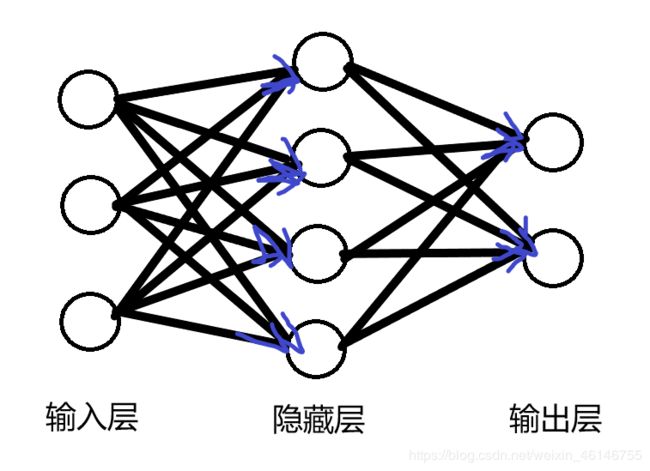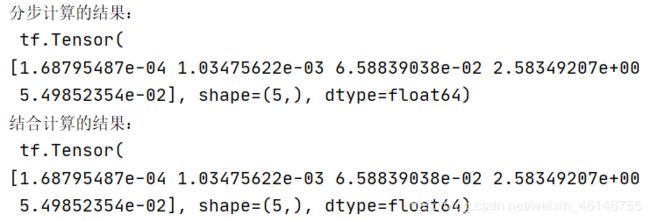人工智能实践:Tensorflow笔记(2)——神经网络优化
文章目录
- 1、预备知识
- 2、神经网络(NN)复杂度
- 3、激活函数
- 4、损失函数
- 5、缓解过拟合
- 6、优化器
1、预备知识
tf.where()
条件语句真返回A,条件语句假返回B
tf.where(条件语句,真返回A,假返回B)import tensorflow as tf
a = tf.constant([1,2,3,1,1])
b = tf.constant([0,1,3,4,5])
c = tf.where(tf.greater(a,b),a,b) #若a>b,返回a对应位置的元素,否则返回b对应位置的元素
print("c:",c)![]()
np.random.RandomState.rand()
返回一个[0,1)之间的随机数
np.random.RandomState.rand(维度) #维度为空,返回标量import numpy as np
rdm = np.random.RandomState(seed=1) #seed=常数每次生成随机数相同
a = rdm.rand() #返回一个随机标量
b = rdm.rand(2,3) #返回维度为2行3列随机数矩阵
print("a:",a)
print("b:",b)np.vstack(数组1,数组2)import numpy as np
a = np.array([1,2,3])
b = np.array([4,5,6])
c = np.vstack((a,b))
print("c:\n",c)
np.mgrid[ ] .ravel() np.c_[ ] 生成网格坐标点
- np.mgrid[ ] [起始值 结束值)
np.mgrid[起始值:结束值:步长,起始值:结束值:步长,...]- x.ravel() 将x变为一维数组,“把.前变量拉直”
- np.c_[ ] 使返回的间隔数值点配对
np.c_[数组1,数组2,...]import numpy as np
x,y = np.mgrid[1:3:1,2:4:0.5]
grid = np.c_[x.ravel(),y.ravel()]
print("x:",x)
print("y:",y)
print("grid:\n",grid)
2、神经网络(NN)复杂度
- NN复杂度:多用NN层数和NN参数的个数表示
空间复杂度:
层数=隐藏层的层数+1个输出层(如图为2层NN)
总参数=总w+总b(如图3 * 4+4(第1层)+4 * 2+2(第2层)=26)
时间复杂度:
乘加运算次数:(如图3 * 4(第1层)+4 * 2(第2层)=20)
- 指数衰减学习率
可以先用较大的学习率,快速得到较优解,然后逐步减小学习率,使模型在训练后期稳定。
指数衰减学习率=初始学习率*学习率衰减率(当前轮数/多少轮衰减一次)
epoch = 40
LR_BASE = 0.2
LR_DECAY = 0.99
LR_STEP = 1
for epoch in range(epoch):
lr = LR_BASE * LR_DECAY ** (epoch / LR_STEP)
with tf.GradientTape() as tape:
loss = tf.square(w+1)
grads = tape.gradient(loss,w)
w.assign_sub(lr * grads)
print("After %s epoch,w is %f,loss is %f,lr is %f" %(epoch,w.numpy(),loss,lr))
3、激活函数

激活函数的加入提升了模型的表达力,使得多层神经网络不再是输入x的线性组合
- 优秀的激活函数:
非线性:激活函数非线性时,多层神经网络可逼近所有函数(只有当激活函数是非线性时,才不会被单层网络所替代,使多层网络有了意义)
可微性:优化器大多用梯度下降更新参数(如果激活函数不可微,就无法更新参数)
单调性:当激活函数是单调的,能保证单层网络的损失函数是凸函数(更容易收敛)
近似恒等性:f(x)约等于x当参数初始化为随机小值时,神经网络更稳定 - 激活函数输出值的范围:
激活函数输出为有限值时,基于梯度的优化方法更稳定(因为权重对特征的影响更显著一些)
激活函数输出为无限值时,建议调小学习率(因为参数的初始值对模型的影响很大)
常用激活函数
Sigmoid函数
tf.nn.sigmoid(x)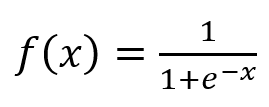

特点:
(1)易造成梯度消失(深层神经网络更新参数时,需要从输出层到输入层进行链式求导,而sigmoid函数的导数输出是0到0.25间的小数,链式求导需要多层导数连续相乘,会出现多个0到0.25之间的连续相乘,结果将趋于0,产生梯度消失,使得参数无法继续更新)
(2)输出非0均值,收敛慢
(3)幂运算复杂,训练时间长
Tanh函数
tf.math.tanh(x)
特点:
(1)输出是0均值
(2)易造成梯度消失
(3)幂运算复杂,训练时间长
Relu函数
tf.nn.relu(x)
优点:
(1)解决了梯度消失问题(在正区间)
(2)只需判断输入是否大于0,计算速度快
(3)收敛速度远快于sigmoid和tanh
缺点:
(1)输出非0均值,收敛慢
(2)Dead Relu问题:某些神经元可能永远不被激活,导致相应的参数永远不能被更新(送入激活函数的输入特征是负数时,激活函数输出是0,反向传播得到的梯度是0)
造成神经元死亡的根本原因:经过relu函数的负数特征过多导致,可以通过改进随机初始化,避免过多的负数特征送入relu函数,通过设置更小的学习率,减少参数分布的巨大变化,避免训练中产生过多负数特征进入relu函数
Leaky Relu函数
tf.nn.leaky_relu(x)

理论上来讲,Leaky Relu有Relu的所有优点,外加不会有Dead Relu问题,但是在实际操作中,并没有完全证明Leaky Relu总是好于Relu
对于初学者选择激活函数:
首选relu激活函数
学习率设置较小值
输入特征标准化,即让输入特征满足以0为均值,1为标准差的正态分布
初始参数中心化,即让随机生成的参数满足以0为均值,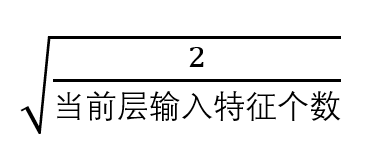 为标准差的正态分布
为标准差的正态分布
4、损失函数
loss_mse = tf.reduce_mean(tf.square(y_-y))预测酸奶日销量y,x1、x2是影响日销量的因素。
建模前,应预先采集的数据有:每日x1、x2和销量y_(即已知答案,最佳情况:产量=销量)
拟造数据集X,Y_:y_=x1+x2 噪声:-0.05~+0.05 拟合可以预测销量的函数
import tensorflow as tf
import numpy as np
SEED = 23455
rdm = np.random.RandomState(seed=SEED) #生成[0,1)之间的随机数
x = rdm.rand(32,2)
y_ = [[x1 + x2 + (rdm.rand() / 10.0 - 0.05)] for (x1,x2) in x] #生成噪声[0,1)/10=[0,0.1);
x = tf.cast(x,dtype=tf.float32)
w1 = tf.Variable(tf.random.normal([2,1],stddev=1,seed=1))
epoch = 15000
lr = 0.002
for epoch in range(epoch):
with tf.GradientTape() as tape:
y = tf.matmul(x,w1)
loss_mse = tf.square(y_-y)
grads = tape.gradient(loss_mse,w1)
w1.assign_sub(lr * grads)
if epoch % 500 == 0:
print("After %d training steps,w1 is " %(epoch))
print(w1.numpy(),"\n")
print("Final w1 is: ",w1.numpy())
可以看出两个参数正向1趋近,最后得到神经网络的参数是接近1的,拟合出的预测销量y的结果y=1.00 * x1+0.99 * x2,该结果和制造数据集公式y=1 * x1+1 * x2一致,说明预测酸奶日销量的公式拟合正确
- 自定义损失函数
如预测产品销量,预测多了,损失成本;预测少了,损失利润。
若利润不等于成本,则mse产生的loss无法利益最大化
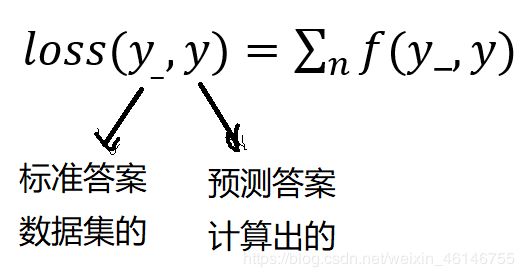


如:预测酸奶销量,酸奶成本(COST)1元,酸奶利润(PROFIT)99元。
预测少了损失利润99元,预测多了损失成本1元。
预测少了损失大,希望生成的预测函数往多了预测。
import tensorflow as tf
import numpy as np
SEED = 23455
COST = 1
PROFIT = 99
rdm = np.random.RandomState(SEED)
x = rdm.rand(32, 2)
y_ = [[x1 + x2 + (rdm.rand() / 10.0 - 0.05)] for (x1, x2) in x] # 生成噪声[0,1)/10=[0,0.1); [0,0.1)-0.05=[-0.05,0.05)
x = tf.cast(x, dtype=tf.float32)
w1 = tf.Variable(tf.random.normal([2, 1], stddev=1, seed=1))
epoch = 10000
lr = 0.002
for epoch in range(epoch):
with tf.GradientTape() as tape:
y = tf.matmul(x, w1)
loss = tf.reduce_sum(tf.where(tf.greater(y, y_), (y - y_) * COST, (y_ - y) * PROFIT))
grads = tape.gradient(loss, w1)
w1.assign_sub(lr * grads)
if epoch % 500 == 0:
print("After %d training steps,w1 is " % (epoch))
print(w1.numpy(), "\n")
print("Final w1 is: ", w1.numpy())
# 自定义损失函数
# 酸奶成本1元, 酸奶利润99元
# 成本很低,利润很高,人们希望多预测些,生成模型系数大于1,往多了预测eg.二分类
已知答案y_=(1,0),预测y1=(0.6,0.4),y2=(0.8,0.2),哪个更接近标准答案?

因为H1>H2,所以y2预测 更准
tf.losses.categorical_crossentropy(y_,y)import tensorflow as tf
loss_ce1 = tf.losses.categorical_crossentropy([1,0],[0.6,0.4])
loss_ce2 = tf.losses.categorical_crossentropy([1,0],[0.8,0.2])
print("loss_ce1:",loss_ce1)
print("loss_ce2:",loss_ce2)- softmax与交叉熵结合
输出先过softmax函数,再计算y与y_的交叉熵损失函数。
tf.nn.softmax_cross_entropy_with_logits(y_,y)import tensorflow as tf
import numpy as np
y_ = np.array([[1,0,0],[0,1,0],[0,0,1],[1,0,0],[0,1,0]])
y = np.array([[12,3,2],[3,10,1],[1,2,5],[4,6.5,1.2],[3,6,1]])
y_pro = tf.nn.softmax(y)
loss_ce1 = tf.losses.categorical_crossentropy(y_,y_pro)
loss_ce2 = tf.nn.softmax_cross_entropy_with_logits(y_,y)
print('分步计算的结果:\n',loss_ce1)
print('结合计算的结果:\n',loss_ce2)5、缓解过拟合
欠拟合和过拟合
欠拟合是模型不能有效拟合数据集,是对现有数据集学习得不够彻底
过拟合是模型对当前数据拟合得太好了,但对未见过的新数据无法做出准确判断,模型缺乏泛化力
- 欠拟合的解决方法:
增加输入特征项
增加网络参数
减少正则化参数 - 过拟合的解决方法:
数据清洗
增大训练集
采用正则化
增大正则化参数 - 正则化缓解过拟合
正则化在损失函数中引入模型复杂度指标,利用给W加权值,弱化了训练数据的噪声(一般不正则化b)



- 正则化的选择
L1正则化大概率会使很多参数变为零,因此该方法可通过稀疏参数,即减少参数的数量,降低复杂度
L2正则化会使参数很接近零但不为零,因此该方法可通过减少参数值的大小降低复杂度
# 导入所需模块
import tensorflow as tf
from matplotlib import pyplot as plt
import numpy as np
import pandas as pd
# 读入数据/标签 生成x_train y_train
df = pd.read_csv('dot.csv')
x_data = np.array(df[['x1', 'x2']])
y_data = np.array(df['y_c'])
x_train = np.vstack(x_data).reshape(-1,2)
y_train = np.vstack(y_data).reshape(-1,1)
Y_c = [['red' if y else 'blue'] for y in y_train]
# 转换x的数据类型,否则后面矩阵相乘时会因数据类型问题报错
x_train = tf.cast(x_train, tf.float32)
y_train = tf.cast(y_train, tf.float32)
# from_tensor_slices函数切分传入的张量的第一个维度,生成相应的数据集,使输入特征和标签值一一对应
train_db = tf.data.Dataset.from_tensor_slices((x_train, y_train)).batch(32)
# 生成神经网络的参数,输入层为2个神经元,隐藏层为11个神经元,1层隐藏层,输出层为1个神经元
# 用tf.Variable()保证参数可训练
w1 = tf.Variable(tf.random.normal([2, 11]), dtype=tf.float32)
b1 = tf.Variable(tf.constant(0.01, shape=[11]))
w2 = tf.Variable(tf.random.normal([11, 1]), dtype=tf.float32)
b2 = tf.Variable(tf.constant(0.01, shape=[1]))
lr = 0.01 # 学习率
epoch = 400 # 循环轮数
# 训练部分
for epoch in range(epoch):
for step, (x_train, y_train) in enumerate(train_db):
with tf.GradientTape() as tape: # 记录梯度信息
h1 = tf.matmul(x_train, w1) + b1 # 记录神经网络乘加运算
h1 = tf.nn.relu(h1)
y = tf.matmul(h1, w2) + b2
# 采用均方误差损失函数mse = mean(sum(y-out)^2)
loss = tf.reduce_mean(tf.square(y_train - y))
# 计算loss对各个参数的梯度
variables = [w1, b1, w2, b2]
grads = tape.gradient(loss, variables)
# 实现梯度更新
# w1 = w1 - lr * w1_grad tape.gradient是自动求导结果与[w1, b1, w2, b2] 索引为0,1,2,3
w1.assign_sub(lr * grads[0])
b1.assign_sub(lr * grads[1])
w2.assign_sub(lr * grads[2])
b2.assign_sub(lr * grads[3])
# 每20个epoch,打印loss信息
if epoch % 20 == 0:
print('epoch:', epoch, 'loss:', float(loss))
# 预测部分
print("*******predict*******")
# xx在-3到3之间以步长为0.01,yy在-3到3之间以步长0.01,生成间隔数值点
xx, yy = np.mgrid[-3:3:.1, -3:3:.1]
# 将xx , yy拉直,并合并配对为二维张量,生成二维坐标点
grid = np.c_[xx.ravel(), yy.ravel()]
grid = tf.cast(grid, tf.float32)
# 将网格坐标点喂入神经网络,进行预测,probs为输出
probs = []
for x_test in grid:
# 使用训练好的参数进行预测
h1 = tf.matmul([x_test], w1) + b1
h1 = tf.nn.relu(h1)
y = tf.matmul(h1, w2) + b2 # y为预测结果
probs.append(y)
# 取第0列给x1,取第1列给x2
x1 = x_data[:, 0]
x2 = x_data[:, 1]
# probs的shape调整成xx的样子
probs = np.array(probs).reshape(xx.shape)
plt.scatter(x1, x2, color=np.squeeze(Y_c)) #squeeze去掉纬度是1的纬度,相当于去掉[['red'],[''blue]],内层括号变为['red','blue']
# 把坐标xx yy和对应的值probs放入contour<[‘kɑntʊr]>函数,给probs值为0.5的所有点上色 plt点show后 显示的是红蓝点的分界线
plt.contour(xx, yy, probs, levels=[.5])
plt.show()
# 读入红蓝点,画出分割线,不包含正则化
# 不清楚的数据,建议print出来查看 # 导入所需模块
import tensorflow as tf
from matplotlib import pyplot as plt
import numpy as np
import pandas as pd
# 读入数据/标签 生成x_train y_train
df = pd.read_csv('dot.csv')
x_data = np.array(df[['x1', 'x2']])
y_data = np.array(df['y_c'])
x_train = x_data
y_train = y_data.reshape(-1, 1)
Y_c = [['red' if y else 'blue'] for y in y_train]
# 转换x的数据类型,否则后面矩阵相乘时会因数据类型问题报错
x_train = tf.cast(x_train, tf.float32)
y_train = tf.cast(y_train, tf.float32)
# from_tensor_slices函数切分传入的张量的第一个维度,生成相应的数据集,使输入特征和标签值一一对应
train_db = tf.data.Dataset.from_tensor_slices((x_train, y_train)).batch(32)
# 生成神经网络的参数,输入层为4个神经元,隐藏层为32个神经元,2层隐藏层,输出层为3个神经元
# 用tf.Variable()保证参数可训练
w1 = tf.Variable(tf.random.normal([2, 11]), dtype=tf.float32)
b1 = tf.Variable(tf.constant(0.01, shape=[11]))
w2 = tf.Variable(tf.random.normal([11, 1]), dtype=tf.float32)
b2 = tf.Variable(tf.constant(0.01, shape=[1]))
lr = 0.01 # 学习率为
epoch = 400 # 循环轮数
# 训练部分
for epoch in range(epoch):
for step, (x_train, y_train) in enumerate(train_db):
with tf.GradientTape() as tape: # 记录梯度信息
h1 = tf.matmul(x_train, w1) + b1 # 记录神经网络乘加运算
h1 = tf.nn.relu(h1)
y = tf.matmul(h1, w2) + b2
# 采用均方误差损失函数mse = mean(sum(y-out)^2)
loss_mse = tf.reduce_mean(tf.square(y_train - y))
# 添加l2正则化
loss_regularization = []
# tf.nn.l2_loss(w)=sum(w ** 2) / 2
loss_regularization.append(tf.nn.l2_loss(w1))
loss_regularization.append(tf.nn.l2_loss(w2))
# 求和
# 例:x=tf.constant(([1,1,1],[1,1,1]))
# tf.reduce_sum(x)
# >>>6
# loss_regularization = tf.reduce_sum(tf.stack(loss_regularization))
loss_regularization = tf.reduce_sum(loss_regularization)
loss = loss_mse + 0.03 * loss_regularization #REGULARIZER = 0.03
# 计算loss对各个参数的梯度
variables = [w1, b1, w2, b2]
grads = tape.gradient(loss, variables)
# 实现梯度更新
# w1 = w1 - lr * w1_grad
w1.assign_sub(lr * grads[0])
b1.assign_sub(lr * grads[1])
w2.assign_sub(lr * grads[2])
b2.assign_sub(lr * grads[3])
# 每200个epoch,打印loss信息
if epoch % 20 == 0:
print('epoch:', epoch, 'loss:', float(loss))
# 预测部分
print("*******predict*******")
# xx在-3到3之间以步长为0.01,yy在-3到3之间以步长0.01,生成间隔数值点
xx, yy = np.mgrid[-3:3:.1, -3:3:.1]
# 将xx, yy拉直,并合并配对为二维张量,生成二维坐标点
grid = np.c_[xx.ravel(), yy.ravel()]
grid = tf.cast(grid, tf.float32)
# 将网格坐标点喂入神经网络,进行预测,probs为输出
probs = []
for x_predict in grid:
# 使用训练好的参数进行预测
h1 = tf.matmul([x_predict], w1) + b1
h1 = tf.nn.relu(h1)
y = tf.matmul(h1, w2) + b2 # y为预测结果
probs.append(y)
# 取第0列给x1,取第1列给x2
x1 = x_data[:, 0]
x2 = x_data[:, 1]
# probs的shape调整成xx的样子
probs = np.array(probs).reshape(xx.shape)
plt.scatter(x1, x2, color=np.squeeze(Y_c))
# 把坐标xx yy和对应的值probs放入contour<[‘kɑntʊr]>函数,给probs值为0.5的所有点上色 plt点show后 显示的是红蓝点的分界线
plt.contour(xx, yy, probs, levels=[.5])
plt.show()
# 读入红蓝点,画出分割线,包含正则化
# 不清楚的数据,建议print出来查看
6、优化器
神经网络优化器
待优化参数w,损失函数loss,学习率lr,每次迭代一个batch,t表示当前batch迭代的总次数:
w1.assign_sub(lr*grads[0])
b1.assign_sub(lr*grads[1])
SGDM(含momentum的SGD) 在SGD基础上增加一阶动量




m_w,m_b = 0,0
beta = 0.9
m_w = beta * m_w + (1 - beta) * grads[0]
m_b = beta * m_b + (1 - beta) * grads[1]
w1.assign_sub(lr * m_w)
b1.assign_sub(lr * m_b)v_w,v_b = 0,0
v_w += tf.square(grads[0])
v_b += tf.square(grads[1])
w1.assign_sub(lr * grads[0] / tf.sqrt(v_w))
b1.assign_sub(lr * grads[1] / tf.sqrt(v_b))v_w,v_b = 0,0
beta = 0.9
v_w = beta * v_w + (1 - beta) * tf.square(grads[0])
v_b = beta * v_b + (1 - beta) * tf.square(grads[1])
w1.assign_sub(lr * grads[0] / tf.sqrt(v_w))
b1.assign_sub(lr * grads[1] / tf.sqrt(v_b))Adam 同时结合SGDM一阶动量和RMSProp二阶动量

修正一阶动量的偏差:


修正二阶动量的偏差:



m_w, m_b = 0, 0
v_w, v_b = 0, 0
beta1, beta2 = 0.9, 0.999
delta_w, delta_b = 0, 0
global_step = 0
m_w = beta1 * m_w + (1 - beta1) * grads[0]
m_b = beta1 * m_b + (1 - beta1) * grads[1]
v_w = beta2 * v_w + (1 - beta2) * tf.square(grads[0])
v_b = beta2 * v_b + (1 - beta2) * tf.square(grads[1])
m_w_correction = m_w / (1 - tf.pow(beta1, int(global_step)))
m_b_correction = m_b / (1 - tf.pow(beta1, int(global_step)))
v_w_correction = v_w / (1 - tf.pow(beta2, int(global_step)))
v_b_correction = v_b / (1 - tf.pow(beta2, int(global_step)))
w1.assign_sub(lr * m_w_correction / tf.sqrt(v_w_correction))
b1.assign_sub(lr * m_b_correction / tf.sqrt(v_b_correction))

